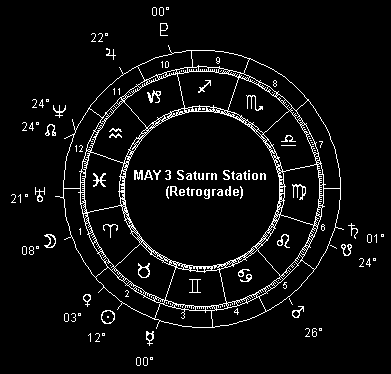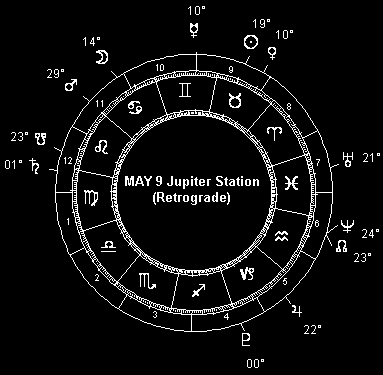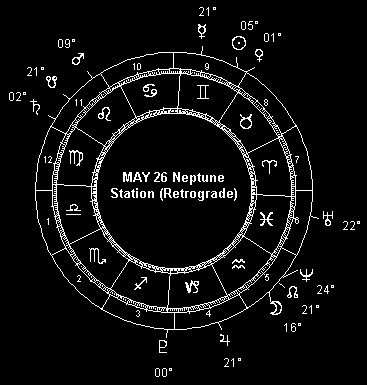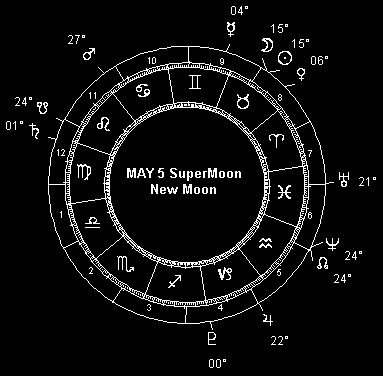If you were expecting some kind of sun sign nonsense, forget about it. This is real astrology for the real world. If it's real astrology for yourself that you want, you can get it by phone or in print. And if you need help deciphering the astrological glyphs in the graphics accompanying this article, see Astroglyphs: Astrological Symbols Guide. Please note: this forecast is expressed in terms of Universal Time (UT).
Live this day as if it were your last . . . the future is not guaranteed.
-- Wayne Dyer
 After a couple of reactionary and transitional months, May is a hefty dose of reality. Manage this and dodge that, fix this and skate by that, respond to this and that so much that there's no time to do anything real and original and creative . . . it's what passes for business as usual most of the time. But it won't pass muster in May. There are so many reasons . . .
After a couple of reactionary and transitional months, May is a hefty dose of reality. Manage this and dodge that, fix this and skate by that, respond to this and that so much that there's no time to do anything real and original and creative . . . it's what passes for business as usual most of the time. But it won't pass muster in May. There are so many reasons . . .
Mercury's second intersolar cycle of the year gets underway this month, starting on the 14th when the diminutive Sun-grazer reaches its greatest elongation east of Sol. Watch for the hard-to-see little world in the western sky after sunset at mid-month, and you may be rewarded with a glimpse of the last of the classical planets to be discovered. Watch for all things mercurial to start building toward critical mass around the same time, and you won't be disappointed. What's mercurial? Everything that has to do with transportation, communication and exchange - the very life blood of our civilization, the stuff we take for granted. From the start of Mercury's intersolar cycle on the 14th, until its end on July 1, paying attention and staying focused are key; and yet they're increasingly hard to do, under what amounts to an overload of information and stimulation.
Beginning with Mercury reaching its maximum elongation east of the Sun (its evening star phase), the intersolar cycle commences with Mercury coming 'round to the same side of the Sun as Planet Earth, putting the little plant relatively near us. Mercury is then pulling up to pass Earth on the inside track, as it were; catching up to us from behind and then passing between us and the Sun. Just as it catches up with us, Mercury passes directly between Earth and the Sun. This is Mercury's inferior conjunction with the Sun, and it happens on June 7 this time around. After the inferior conjunction, Mercury continues pulling ahead of us until it reaches the July 1 greatest elongation west of the Sun (its morning star phase), at which point the little planet is headed toward the far side of our parent star. Between these two extremes, the greatest east and west elongations, comes the fabled Mercury retrograde period of astrological lore: May 26-June 19, this time around.
 Retrograde means moving backwards. This is what Mercury appears to do in our skies when the little inner planet catches up on us and passes us on the inside, between Earth and the Sun. First its forward progress in the sky begins to slow, as Mercury approaches its greatest eastern elongation; then the little planet appears to stand still in the sky (the retrograde station); and then it appears to move backwards through the heavens for a period of several weeks: that's Mercury retrograde for you. It ends when the little Sun-grazer's backwards motion comes to an apparent halt (the direct station); after which, Mercury moves forward again, until it reaches its maximum elongation west of the Sun. The reality of course is that Mercury never stops in its orbit, and never moves backward: this is only how the relative motions of Earth and Mercury around the Sun cause Mercury to move through our night sky. (See the animated illustration for a celestial bird's eye view of what's happening.)
Retrograde means moving backwards. This is what Mercury appears to do in our skies when the little inner planet catches up on us and passes us on the inside, between Earth and the Sun. First its forward progress in the sky begins to slow, as Mercury approaches its greatest eastern elongation; then the little planet appears to stand still in the sky (the retrograde station); and then it appears to move backwards through the heavens for a period of several weeks: that's Mercury retrograde for you. It ends when the little Sun-grazer's backwards motion comes to an apparent halt (the direct station); after which, Mercury moves forward again, until it reaches its maximum elongation west of the Sun. The reality of course is that Mercury never stops in its orbit, and never moves backward: this is only how the relative motions of Earth and Mercury around the Sun cause Mercury to move through our night sky. (See the animated illustration for a celestial bird's eye view of what's happening.)
Mercury retrograde is the cycle when everything goes wrong, to hear some astrologers tell it. The truth is not so simple-minded. All things Mercurial are crucial during the intersolar Mercury phase; infrastructure, commerce, information, communication and transport being prime examples. Absent careful investigation and planning, and conscientious follow-through, all such things are apt to go off track during these cycles. Mercury's intersolar phase is a time for focus, concentration, planning, conscientious double-checking, follow-through and communication - all the qualities of the active and involved mind, in short. Alas, most people are not especially alert and focused most of the time. When this kind of sleepwalking runs into Mercury's intersolar cycle, with its focus on mental acuity, it doesn't take long for things to go awry.
If you're sharp and focused and alert, you can avoid a certain amount of this mess. In fact, you can even prosper by concentrating on tasks that center on thought, planning and communication. But you'll still have to dodge all the chaos created by the people who are sleepwalking. It's not so much that disaster is destined to strike when Mercury is in its intersolar phase. Rather, it's that everything pertaining to Mercury becomes crucial; and unless it's treated as such, then it goes awry. More and more, we live in a "just in time" world - and if the slightest delay holds up just one single thing, then a whole process screeches to a halt. Unfortunately, few people keep their eye on the ball with any consistency and diligence. And that's the reason these Mercury cycles tend to turn into Murphy's Law festivals. Don't say I didn't warn you!
Among the sort of things to be ready for during the above mentioned Mercury intersolar cycles: strikes and other disruptions affecting transportation and communication (e.g. postal, phone, mass transit, trucking, airline, shipping, dock and warehouse workers, teachers and all manner of media). Weather both terrestrial and solar (including geomagnetic storms) can play a part in the kind of breakdowns described here, but human effort is a part of the mix as well - sometimes maliciously, sometimes just accidentally. Power failures due to infrastructure breakdown, and computer network disruptions caused by hacker attacks, software vulnerabilities and the like are also just a crossed wire or a keystroke away from a major mess at these times.
 If I had to pick a day to have a backup generator all fueled up and ready to go, a contingency plan in place in case the scheduled or expected didn't come to pass, a day to be especially sharp and steady and focused - it would be around the critical points in this cycle: May 14, May 26, June 7 and 19, and July 1. Note these dates; be ready with a fallback plan just in case.
If I had to pick a day to have a backup generator all fueled up and ready to go, a contingency plan in place in case the scheduled or expected didn't come to pass, a day to be especially sharp and steady and focused - it would be around the critical points in this cycle: May 14, May 26, June 7 and 19, and July 1. Note these dates; be ready with a fallback plan just in case.
There's been a lot of Mars action in the heavens ever since last year, when Earth began its biennial close encounter with the Red Planet. Basically in effect from September 2007 until last month, the extreme Mars action is done for the year. But there are still some spikes left, including May 21 (Mars at the opposition point to the January 26, 2009 lunar eclipse) and 28 (Mars crossing over the degree of the August 1, 2008 solar eclipse). These are dates, give or take about a week, when you want to keep your wits about you, your focus on your immediate situation. No daydreaming - this is a time to stay aware and safety-conscious! These are periods of elevated tension and conflict, the kind of atmosphere that cultivates inflamed passions, hot tempers and rash, even violent action - of the criminal and military type, even.
Apart from the direct impact of the fires, clashes, crashes and explosions that are par for the course under this sort of Mars activation, some such incidents can raise the possibility of a disruption in the oil and natural gas supply chain - which in turn can shock the financial markets and put investors and institutions in a mad dash for the exits. As I've warned since last year, these Mars factors are part of a celestial pattern that says "$100 a barrel oil, $800 an ounce gold and two dollar pounds will look like a bargain." Of course it has all since come to pass. And yes, there will be fluctuations (the downward sort being buying opportunities, by and large). The bottom line is that markets are a balance of fear and greed, with fear setting the tone when the Red Planet is prominent - as it is, late in the month of May.
The economic factors just mentioned are linked to way more than the Mars action this month. In fact, the Mars stuff is more like the last straw; the trigger that gets squeezed once the magazine is loaded and stuffed and the slide is pulled. The real underlying tension is associated with the big planet (Jupiter, Saturn and Neptune) stations of May, as well as the aftermath of April's Pluto retrograde station (which doesn't move off its station degree until it retrogrades back into Sagittarius in mid-June); not to mention the Neptune-north lunar node alignment of late April-early May. Add them all up, and they look to me like signs that we're nearing the end of a brief recovery from the downdrafts in the world financial system that were so much in evidence in February (the last Mercury intersolar phase and the last set of eclipses), as part of the longer cycle planetary phases that started the downslide last year (see my 2007 forecast).
 Now May brings another Mercury intersolar cycle, and a Sun-Moon-Earth alignment every bit as potent as an eclipse; namely the first SuperMoon of the year. This won't happen all at once - as I've said from the start - but I don't think it's the sort of thing no one will notice, even if it does take until late August to hit its stride for now. My guess is that recent apparent recoveries in the credit system and equity markets will be revealed as the fruit of quick fixes that carry their own set of problems. Instead of putting problems behind us, the bankers and politicians have only postponed a day of reckoning. They've borrowed from the future to survive the present, which is fine as long as the future never comes.
Now May brings another Mercury intersolar cycle, and a Sun-Moon-Earth alignment every bit as potent as an eclipse; namely the first SuperMoon of the year. This won't happen all at once - as I've said from the start - but I don't think it's the sort of thing no one will notice, even if it does take until late August to hit its stride for now. My guess is that recent apparent recoveries in the credit system and equity markets will be revealed as the fruit of quick fixes that carry their own set of problems. Instead of putting problems behind us, the bankers and politicians have only postponed a day of reckoning. They've borrowed from the future to survive the present, which is fine as long as the future never comes.
What are the likely market panic and financial freeze-up dates this month? Take your pick: Saturn's direct station on the 3rd, the Neptune alignment on the moon's true node on the 4th, the SuperMoon on the 5th, Jupiter's retrograde station on the 9th, Neptune's retrograde station on the 24th, Mercury's retrograde station on the 26th . . . anyone of them could be the tipping point, and all but a couple are within a degree of exact the whole month long anyway. A good time to take profits on equities generally, a good time to remember that commodities and the companies that produce them are the foundation that's left when a fiat monetary system and speculative equity market crumbles. Pick and choose your way, recognizing that what resumes in May won't hit full throttle until August. (And even that won't be much more than the just the latest salvo in a barrage that began years ago, and really won't get back to comparative normalcy until sometime in the next decade.)
Last month's forecast mentioned some of the practical steps we can all take to get through this. If you beat the rush to get your "pantry well-stocked with non-perishables," then you're not running into rice-free stores at least. Take advantage of price pullbacks in non-perishable commodities whenever you can, and use them to stock up - whether it's rice, flour, silver, gold or what-have-you.
 Speaking of last month, I mentioned then that "really big disturbances are waiting just around the corner with the SuperMoons in May and June . . . the kind that surge through the atmosphere, oceans and crust of our home planet." It's May, and the year's first SuperMoon is exact on the 5th, and in effect from the 1st (in advance of the Moon's northward crossing of the celestial equator on the 2nd) through the 9th (following the north lunar declination peak on the 8th). By now, you should know what a SuperMoon is and what to expect, as I've explained many times before. At the every least, do what you can to be prepared for severe storms with high winds and heavy precipitation as well as moderate to severe seismic activity (magnitude 5+ earthquakes and volcanic activity). The latter tend to happen in well-known seismic risk zones of course, while the former can pop up anywhere there's a sky above. SuperMoons, after all, are planetary in scale and scope. That said, there are some astro-locality risk zones for this particular SuperMoon along a longitudinal line that sweeps from the British Isles down through western Europe and west Africa in the western hemisphere, and across New Zealand in the east. A horizon arc from this SuperMoon sweeps through Alaska and the western US and Canada, down through Mexico and across the southern tip of South America, coming up eastern India into China, Mongolia and Siberia. I'm also seeing some rather threatening looking Mars lines sweeping from Anchorage across to Edmonton and down through New Orleans and Buenos Aires, across open ocean to southeastern Australia.
Speaking of last month, I mentioned then that "really big disturbances are waiting just around the corner with the SuperMoons in May and June . . . the kind that surge through the atmosphere, oceans and crust of our home planet." It's May, and the year's first SuperMoon is exact on the 5th, and in effect from the 1st (in advance of the Moon's northward crossing of the celestial equator on the 2nd) through the 9th (following the north lunar declination peak on the 8th). By now, you should know what a SuperMoon is and what to expect, as I've explained many times before. At the every least, do what you can to be prepared for severe storms with high winds and heavy precipitation as well as moderate to severe seismic activity (magnitude 5+ earthquakes and volcanic activity). The latter tend to happen in well-known seismic risk zones of course, while the former can pop up anywhere there's a sky above. SuperMoons, after all, are planetary in scale and scope. That said, there are some astro-locality risk zones for this particular SuperMoon along a longitudinal line that sweeps from the British Isles down through western Europe and west Africa in the western hemisphere, and across New Zealand in the east. A horizon arc from this SuperMoon sweeps through Alaska and the western US and Canada, down through Mexico and across the southern tip of South America, coming up eastern India into China, Mongolia and Siberia. I'm also seeing some rather threatening looking Mars lines sweeping from Anchorage across to Edmonton and down through New Orleans and Buenos Aires, across open ocean to southeastern Australia.
Really, I'm not an alarmist. The vast majority of people and places on this good planet will be fine at the end of the SuperMoon risk window. All I'm saying is, where's the harm in having a few extra fresh batteries and candles, some extra bottled water and canned goods, maybe a full tank of gas and an evacuation bag packed just in case? And maybe you'll think twice about being in transit and more than usually vulnerable to the vagaries of weather hazards and delays. These may amount to only minor inconveniences. But they're the kind of sensible precautions that can make a big difference if the worst does come to pass.
The SuperMoon at the beginning of May is not the sole storm and seismic risk indicator for the month, though it may be the biggest. Others crop up May 13-15, May 17-23, and from the 28th through the end of the month and on into early June, what with the next SuperMoon lining up in the sky on the 3rd. We've had a fairly quiet run of geophysical activity the last couple months, and it's come to an end.
 SPECIAL FEATURE: This month's birthdays of the famous and infamous (with astrological birth charts)
SPECIAL FEATURE: This month's birthdays of the famous and infamous (with astrological birth charts)